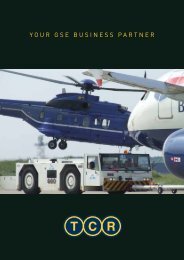WE BRING YOU SAFELY TO TAKE-OFF. - TCR Group
WE BRING YOU SAFELY TO TAKE-OFF. - TCR Group
WE BRING YOU SAFELY TO TAKE-OFF. - TCR Group
Create successful ePaper yourself
Turn your PDF publications into a flip-book with our unique Google optimized e-Paper software.
FEATURE | MILITARY<br />
GSE Services<br />
stays ahead<br />
Tendering for Australian Defence Organisation GSE<br />
provision is no simple or speedy process and there is no<br />
way of ensuring success<br />
“It’s a highly competitive market”<br />
credit: Australian Department of Defence<br />
Power Stow<br />
Rollertrack Conveyor<br />
The Versatile Belt Loader Extension<br />
See our Live Demo<br />
(Booth #1311) at the<br />
International Airport Expo,<br />
Las Vegas Sept 25th – 27th<br />
Ryan Daly, a sales manager at Queensland-based GSE Services, acknowledges that the tender<br />
process used by the Australian Defence Organisation (ADO) is the fairest method of determining<br />
who wins commercial contracts. But it doesn’t make it an easy ride for his company.<br />
GSE Services, which is an offshoot of the military procurement company Milspec Services,<br />
has already won a number of contracts from the Australian military, chiefl y for pushback tractors.<br />
Although GSE Services also sells to domestic airlines, the ADO is a vital part of its business.<br />
But it’s a highly competitive market. GSE Services is one of a number of suppliers to the Australian<br />
military - most of which work in conjunction with overseas manufacturers - and so the company has<br />
to fi ght ferociously hard to win lucrative contracts. Daly describes the bidding process as extremely<br />
time-consuming, and there is no guarantee of success.<br />
GSE Services has to continually monitor the AusTender website (www.tenders.gov.au) for news<br />
of requests for interest (RFIs). These RFIs are put out by the Defence Materiel Organisation, the<br />
government agency responsible for the acquisition, support and disposal of equipment for the<br />
Australian military.<br />
When GSE Services spots an RFI which falls within its remit, it has to act fast. First, it must decipher<br />
pages of “legal mumbo-jumbo”, then it has to invest time and money in putting a bid together.<br />
Third, is has to sit back and wait.<br />
“Everything goes out for tender now, so that the process is fair to everyone and there’s no bias, but<br />
it’s a painstaking process,” Daly said. “They can take months to make the decision and even after you<br />
win a tender, they are not bound by any law to pursue the purchase. They can pull out at any minute<br />
if budgets get cut in a recession, or we get a change of government.”<br />
Requests for tender (RFTs) are published in accordance with Commonwealth Procurement Rules.<br />
The request must include the closing date, a description of the services required, and a set of terms<br />
and conditions.<br />
For GSE equipment, the Royal Australian Air Force (RAAF) will tell the Defence Materiel Organisation<br />
(DMO) what it requires and give them an estimated budget. The DMO then has to go and source<br />
it for them.<br />
“The fi nal decision to buy is based on a value-for-money assessment of the total cost, including<br />
support maintenance and disposal costs,” says Jonathan Anglin, systems program offi ce director at<br />
the DMO.<br />
“But we also try to be as fl exible as possible. The majority of GSE procurements are outright purchases,<br />
but where a leasing arrangement demonstrates better value for money, it is also considered.”<br />
When additional vehicles are added to an existing fl eet it may be cost-effective to buy directly<br />
from the previous supplier or manufacturer. Maintaining a standard fl eet simplifi es the purchasing<br />
process and reduces maintenance costs.<br />
“After we receive the parts, the majority of operational maintenance, such as changing oil and<br />
tyres, is done by the RAAF services, but most of the deeper level maintenance is provided by the<br />
suppliers,” said Anglin.<br />
A powered rollertrack extension built into<br />
an existing, ground based belt conveyor.<br />
Facilitating the loading and offloading of<br />
passenger baggage inside the aircraft cargo<br />
hold.<br />
– Reduced manpower requirement<br />
– No additional weight during flight<br />
– Faster loading and offloading<br />
– Enhanced working environment<br />
– Fast pay-back, low operating costs<br />
– Easy access to all parts of the cargo hold<br />
– Special roller design for exceptional stability<br />
– Easy to use<br />
– Robust, easy to service and maintain<br />
Visit www.powerstow.com for more information and live video demonstration!<br />
30 AIRSIDE INTERNATIONAL | OC<strong>TO</strong>BER 2012 WWW.AIRSIDEINT.COM



